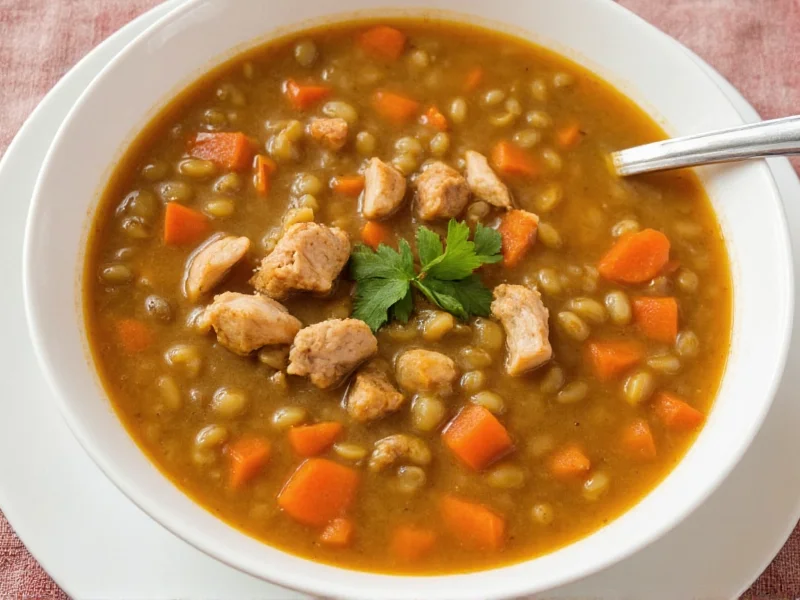Creating the perfect chicken lentil soup requires understanding ingredient synergy and proper cooking techniques. This traditional preparation method maximizes flavor development while preserving nutritional value. The magic happens when the collagen from chicken bones transforms into gelatin during simmering, creating that signature rich texture home cooks seek in comforting chicken lentil soup recipes.
Essential Ingredients for Authentic Flavor
Selecting quality components makes all the difference in your easy chicken lentil soup recipe. For optimal results:
- Chicken: Bone-in thighs provide richer flavor than breast meat, but boneless works for quicker preparation
- Lentils: Green or brown lentils hold shape better than red varieties during cooking
- Aromatics: Yellow onions, carrots, and celery form the flavor foundation (mirepoix)
- Seasonings: Bay leaves, thyme, and black pepper enhance without overpowering
- Liquid: Low-sodium chicken broth maintains control over salt content
Step-by-Step Preparation Guide
Follow this professional technique for healthy chicken lentil soup with perfect texture every time:
- Sauté onions, carrots, and celery in olive oil until softened (8-10 minutes)
- Add minced garlic and cook 1 minute until fragrant
- Stir in 1½ cups rinsed lentils and 6 cups broth
- Bring to boil, then reduce heat and add 1 lb chicken pieces
- Simmer covered for 25-30 minutes until lentils are tender but not mushy
- Remove chicken, shred, and return to pot
- Season with salt, pepper, and 2 tbsp lemon juice to brighten flavors
- Add chopped parsley before serving
Nutritional Benefits Analysis
| Nutrient | Per Serving (1.5 cups) | Daily Value% |
|---|---|---|
| Calories | 290 | 15% |
| Protein | 30g | 60% |
| Fiber | 15g | 54% |
| Iron | 6.7mg | 37% |
| Vitamin A | 8500IU | 170% |
This high protein chicken lentil soup delivers complete nutrition in one bowl. Lentils provide slow-digesting carbohydrates and plant-based iron, while chicken contributes complete protein. The combination creates a satiating meal that stabilizes blood sugar - ideal for chicken lentil soup for meal prep throughout the week.
Proven Cooking Techniques for Best Results
Avoid common pitfalls with these chef-recommended adjustments for your traditional chicken lentil soup preparation:
- Acid balance: Add lemon juice or vinegar at the end to enhance flavors without breaking down lentils
- Texture control: Don't oversalt initially - lentils absorb seasoning as they cook
- Time management: For quick chicken lentil soup for busy weeknights, use pre-cooked rotisserie chicken (add at the end)
- Flavor depth: Sauté tomato paste with vegetables for 2 minutes before adding liquids
Variations for Dietary Needs
Adapt this versatile recipe for specific requirements while maintaining authentic taste:
- Gluten-free: Naturally compliant - verify broth is certified GF
- Vegan option: Substitute vegetable broth and omit chicken (add mushrooms for umami)
- Spicy version: Include ½ tsp cumin and cayenne with aromatics
- Instant Pot method: Cook on high pressure for 10 minutes with quick release
Storage and Reheating Guidelines
This nutritious chicken lentil soup improves with time as flavors meld. Store properly for maximum freshness:
- Cool completely before refrigerating (within 2 hours of cooking)
- Store in airtight containers for up to 5 days
- Freeze portions for up to 3 months (thaw overnight in refrigerator)
- Reheat gently on stove with splash of water to restore consistency
Frequently Asked Questions
Can I use canned lentils for chicken lentil soup?
Canned lentils work in a pinch but require recipe adjustments. Drain and rinse them thoroughly, then add during the last 10 minutes of cooking to prevent mushiness. Reduce liquid by 1 cup since canned lentils contain extra moisture. Expect slightly less texture control compared to dried lentils.
Why did my lentils turn out mushy in chicken soup?
Mushy lentils typically result from overcooking or using red lentils which break down faster. For firmer texture, use green or brown lentils and simmer just until tender (25-30 minutes). Avoid adding acidic ingredients like tomatoes early in cooking, as this prolongs lentil softening time. Check lentils 5 minutes before recipe suggests.
How can I thicken chicken lentil soup without flour?
Naturally thicken soup by blending 1 cup of cooked soup and returning it to the pot. Mashed potatoes or cooked rice added near the end also create creaminess. For authentic texture, simply simmer uncovered for 10-15 minutes to reduce liquid while stirring occasionally to prevent sticking.
What vegetables pair well with chicken lentil soup?
Traditional additions include carrots, celery, and onions. For extra nutrition, stir in spinach or kale during the last 5 minutes. Root vegetables like parsnips or turnips add earthy sweetness when diced small. Avoid watery vegetables like zucchini which can make soup thin. Frozen peas added at serving provide nice color contrast.
Is chicken lentil soup suitable for freezing?
Yes, chicken lentil soup freezes exceptionally well due to its hearty ingredients. Cool completely before portioning into freezer-safe containers with 1-inch headspace. Thaw overnight in refrigerator before reheating. Texture remains excellent for up to 3 months, though flavor peaks within 6 weeks. Stir well after reheating as separation may occur.











 浙公网安备
33010002000092号
浙公网安备
33010002000092号 浙B2-20120091-4
浙B2-20120091-4